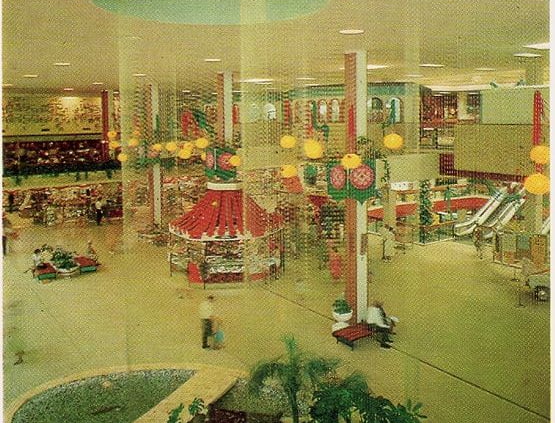How The Times Impacted the Designs of Shopfitting
As we saw in the first section on shopping centres in the previous edition of Interior Fitout, they heralded in a dramatic change not only to the way we shopped, but also to the entire model of shopfitting. At the time Chermside, Chadstone and Top Ryde opened in the late 1950’s, they were regarded almost as tourist attractions, but they were just the start of a very rapid expansion.
When Chermside opened in Brisbane in 1957, it had one department store, one supermarket and 24 specialty stores; it now has a lettable area of around 150,000 square metres, six department stores and some 400 specialty stores. Chadstone in Victoria was originally a single level open air mall with two rows of stores linking Myer at one end and a supermarket at the other. Today it has around 221,000 square metres of lettable area and around 530 stores, making it the largest shopping centre in Australia.
In 1965, Roselands shopping centre opened in Sydney and it embodied many firsts that were to set a pattern for the centres that followed. Unlike the earlier centres, it drew large crowds not just for the retail stores but for its novelty and ambience. It was at the time it opened in 1965, the largest shopping centre in the southern hemisphere. It had Australia’s first ‘food court’ as well as a cinema. Crowds came long distances to marvel at the Raindrop Fountain. Theatre had come to retailing.
From the mid 1960’s we saw the start of the explosion of shopping centre development in every state. Whilst it is impossible to be exact, and the figures depend on a definition of what constitutes a shopping centre, the following table of openings in the metro area of each state provides an indication of the pace of development.
1960-70
QL~ 0
VIC~ 6
SA~ 2
NSW~ 8
1970-80
QLD~ 6
VIC~ 13
SA~ 4
NSW~16
1980-90
QLD~ 10
VIC~ 5
SA~5
NSW~ 1
Totals
1960-70
16
1970-80
39
1980-90
21
Figures for WA, NT and Tasmania are not available, but presumably they followed the same pattern.
The most recent figures available show the current number and distribution of shopping centres in Australia.
CBD
VIC~ 14
NSW~ 15
QLD~9
SA~6
TAS~0
ACT~1
WA~7
Suburban
VIC~ 42
NSW~ 44
QLD~19
SA~12
TAS~5
ACT~7
WA~33
SA~12
TAS~5
ACT~7
WA~33
Regional
VIC ~ 16
NSW~ 24
QLD~ 29
SA~ 8
TAS~ 1
ACT~ 0
WA~ 8
Totals
CBD
52
Suburban
162
Regional
86
By the time Miranda Fair opened in 1969, the concept of shopping centres being more than just a conglomeration of shops was well entrenched, and retailers were expected to play their part in the theatre. Not all retail activity was in shopping centres. Most country towns had at least one major retailer who were general merchants selling everything from clothing, homewares, furniture, jewellery, grocery, hardware and rural requirements. These stores were usually owned and controlled by local identities, but many were taken over by larger companies and sadly ceased to operate with the advent of shopping malls in their district. This was the case with the very strong Newcastle and District Cooperative, with their group known as THE STORE throughout the Hunter region of NSW.
The next major impact to retailing came in April 1969 when Coles, in conjunction with the USA Kresage Corp., opened the first Kmart Discount Store in Melbourne’s Burwood East, with the second store at Blacktown in Western Sydney opening shortly after. This was a completely new style of retailing to which customers had to become familiar before being comfortable in this environment. The full checkout payment system in the early stages was foreign to the normal way of shopping. Following a study tour of the USA, Geelong based Lindsay McKenzie undertook a revamp of their stores to this new discount concept, rebadging them as Lindsay Target which later became Target when acquired by Myer. Other chains such as Best and Less, Venture and Fosseys, to name a few, were drawn to this type of approach.
In 1992 one of the most dramatic changes in retailing came in the area of hardware stores. Two major companies, Westfarmers with Bunnings, and Burns Philp with Hardware House, embarked on the “big box” concept stores along with the USA Home Depot store format, which they adapted to suit local conditions. These stores were an immediate success and have continued to grow in size and also in the number of sites throughout Australia. All Hardware House outlets were ultimately taken over by Westfarmers and merged in to Bunnings.
Ikea, the Swedish house and homewares stores, have had the “big box” concept for some time and today we now see electrical, stationary & office supplies and liquor stores all adopting the same philosophies to selling.


Leave a Reply
Want to join the discussion?Feel free to contribute!